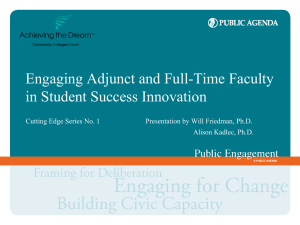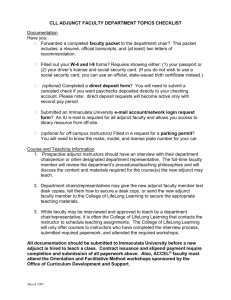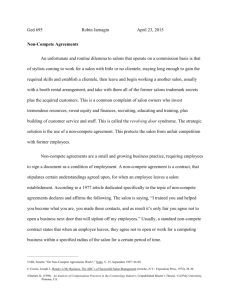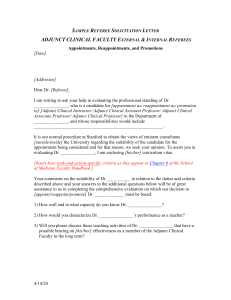Online Professor Salary, Job Opportunity
advertisement
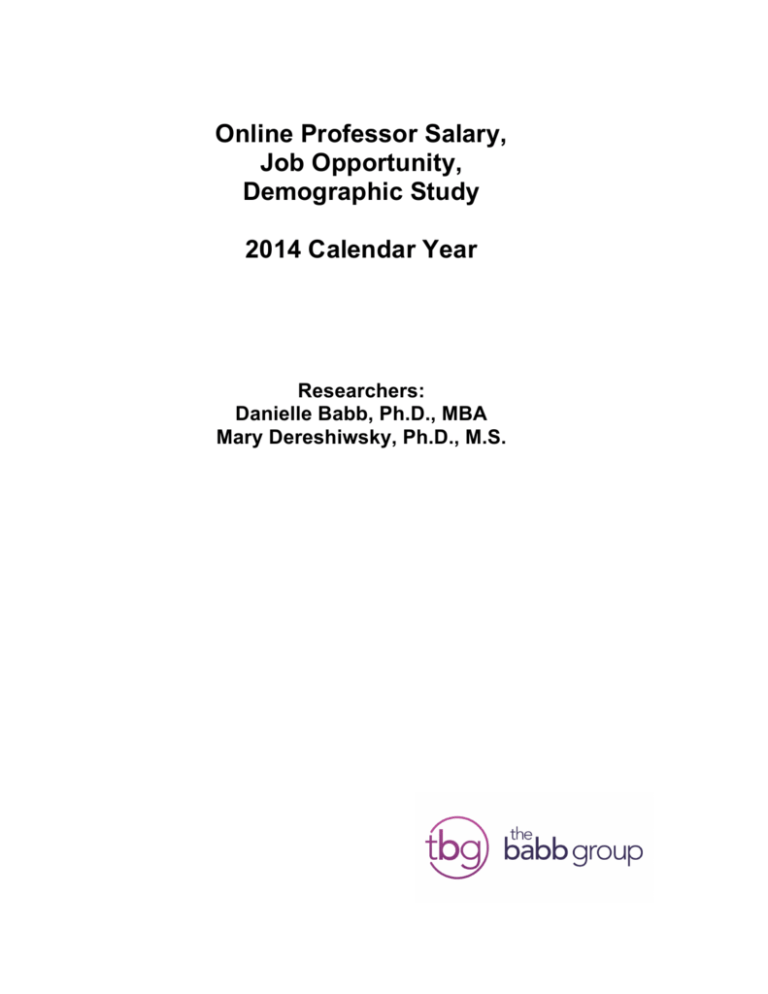
Online Professor Salary, Job Opportunity, Demographic Study 2014 Calendar Year Researchers: Danielle Babb, Ph.D., MBA Mary Dereshiwsky, Ph.D., M.S. 2014 Online Professor Salary, Job Opportunity, Demographic Study Study Introduction as presented to participants: The Babb Group, Inc. and researcher Danielle Babb, PhD, MBA is conducting research on online faculty salaries, opportunity and satisfaction. The survey will be conducted annually. Reports will be summarized and provided at www.thebabbgroup.com/blog. Sign up for the newsletter to receive notification of when the results are available. http://www.thebabbgroup.com/our-newsletter.html The purpose of this study is to determine faculty job satisfaction and factors contributing to it, mean pay by job type, information about finding new work and employment opportunities, demographics of online professors, policy and procedures, training and contract types. No user identifiable information is collected and all responses are anonymous. The report will be made available at no cost. If you have suggestions on additional questions to include in next years survey please contact dbabb@thebabbgroup.com. By participating in this study you agree to hold its creators, participants and those aggregating and publishing summary reports harmless for any real or perceived harm. The survey administrators will publish the results in aggregate summary format, and do not track and will not collect any other identifying information. For more information please visit www.thebabbgroup.com. Please follow us on LinkedIn, Twitter or Facebook to be notified when the results are published. Total number of responses: 172 Number of completed responses varies by question. Number of questions: 58 Reproduction and right to use: Intellectual Property and Copyright: The Babb Group, Inc. 2015. This research and study outcomes may be sourced and referenced with the full citation in peer-reviewed research without permission. All other uses of the study must be granted in writing, including the use of the data for institutional management and effectiveness. Please email dbabb@thebabbgroup.com with Name, Title, Organization, Intent to Use, and For Profit or Not for Profit Activity. Background The Online Professor Survey, Demographic Study Survey was disseminated via Survey Monkey to online faculty through Facebook Groups, LinkedIn, and member sharing. Individuals with online teaching experience were encouraged to participate. The survey consisted of 58 fixed-response and open-ended questions. The question categories included demographics (e.g., age; education; region of country, primary source of income, 2014 total income further subdivided into teaching, course development and mentoring), schools worked for (e.g., full-time vs. part-time; online vs. brick and mortar; profit vs. non-profit); insurance and benefits status, attitudes towards non-compete agreements; and intent to secure more teaching opportunities. Method A total of 173 subjects responded to the survey. Survey response data were exported from SurveyMonkey and formatted as a data file in IBM SPSS 21 for data analysis. Due to the number of missing values/non-responses across various survey questions, the survey data could not be analyzed inferentially. We searched for patterns, themes and trends of response by generating contingency tables and analyzing them descriptively. Preliminary Results Following are some preliminary conclusions derived from these contingency tables: --The fewer part-time contracts, the more likely to say that non-compete is unfair to faculty --Equally likely to violate or not violate non-compete agreements if only 1 or 2 part-time contracts --34 to 49 age groups twice as likely to believe non-compete agreements are not enforceable. For youngest group, 20 to 29, almost twice as likely to believe non-compete agreements are enforceable --Almost twice as many women are likely to believe non-compete agreements are not enforceable, as compared to 1 ½ times as many men --34 to 39 year olds are most likely to be waiting for part-time course assignments --Majority of respondents would not violate non-compete agreement regardless of number of schools they work for --Those who hold master’s degrees are most likely to believe non-compete agreements aren’t fair to faculty Recommendations and Implications --Conduct an item analysis on the survey to identify and eliminate those questions with high nonresponse. Eliminate these survey questions in a 2015 replication of the survey study using a shorter, more streamlined survey. --Conduct individual or focus group interviews using technology (e.g., online chat room) to probe for further information behind the preliminary findings and conclusions (e.g., how and why the survey subjects answered as they did). --Conduct a follow-up phenomenology with a select purposive sample of online faculty to capture their lived experience regarding satisfaction levels with online teaching particularly in the areas included in the survey (e.g., attitudes towards benefits and health insurance; attitudes towards non-compete agreements)> --With a larger response rate and a streamlined survey, conduct a factor analysis to uncover the underlying overall dimensions of faculty attitudes towards, and satisfaction with, online teaching. --Conduct a case study, including cross-case analysis, to further uncover areas of similarity and difference by some of the key demographic variables included in the original survey study (e.g., level of education; age range; gender; level of experience in teaching online). --With a larger response rate and a streamlined survey, develop and test predictive discriminant analysis models to identify the demographics that most widely differentiate subjects’ attitudes and satisfaction levels. --Locate and administer, with prior permission, a satisfaction survey to correlate to ratings of satisfaction as noted on the online survey to further discover the dimensions of online teaching satisfaction. Demographics The demographic portion of this survey is designed to understand the current demographics of the respondent and the demographics at the time he or she began teaching. This section also collects income and earnings from teaching activities. This section collects data to determine military service and other industry-based sources of employment or income. Following is a profile of a typical survey respondent. This profile was derived from generating model (most frequently occurring) response categories from the survey demographic variables. The complete set of frequency tables for each demographic variable is included in an appendix. The typical survey respondent is described as follows: --Between age 40 and 49, --Started teaching between age 40 and 49, --Female, --Currently holding a master’s degree, --Held a master’s degree prior to starting teaching, --Not currently enrolled in a degree program, --Lives in the East North Central region, --Earned $9,999 or less from teaching during 2014, --Earned $4,999 or less from course development during 2014, --Earned $4,999 or less from mentoring during 2014, --Has never served in the military, --Primary income source is office and administrative support. Detailed supportive data follows: Current Age Frequency Percent Valid Percent Cumulative Percent Valid Missing Total 26-33 14 7.3 8.2 8.2 34-39 25 13.0 14.6 22.8 40-49 63 32.6 36.8 59.6 50-59 50 25.9 29.2 88.9 60+ 19 9.8 11.1 100.0 Total 171 88.6 100.0 22 11.4 193 100.0 System Age Start Teaching Frequency Percent Valid Percent Cumulative Percent Valid Missing 18-25 18 9.3 10.5 10.5 26-33 41 21.2 24.0 34.5 34-39 43 22.3 25.1 59.6 40-49 45 23.3 26.3 86.0 50-59 19 9.8 11.1 97.1 60+ 4 2.1 2.3 99.4 Other 1 .5 .6 100.0 Total 171 88.6 100.0 22 11.4 193 100.0 System Total Gender Frequency Percent Valid Percent Cumulative Percent Male Valid Missing Total 68 35.2 39.8 39.8 Female 103 53.4 60.2 100.0 Total 171 88.6 100.0 22 11.4 193 100.0 System College Completed Frequency Percent Valid Percent Cumulative Percent Valid Associate 1 .5 .6 .6 Bachelor's 5 2.6 2.9 3.5 Master's 88 45.6 51.8 55.3 Doctoral Academic 51 26.4 30.0 85.3 Doctoral Professional 25 13.0 14.7 100.0 170 88.1 100.0 1 .5 System 22 11.4 Total 23 11.9 193 100.0 Total 25 Missing Total Highest Degree Before Teaching Frequency Percent Valid Percent Cumulative Percent Bachelor's 17 8.8 10.1 10.1 120 62.2 71.0 81.1 Doctoral Academic 16 8.3 9.5 90.5 Doctoral Professional 16 8.3 9.5 100.0 169 87.6 100.0 2 1.0 System 22 11.4 Total 24 12.4 193 100.0 Master's Valid Total 25 Missing Total Country Frequency Percent Valid Percent Cumulative Percent USA Valid 164 85.0 97.0 97.0 5 2.6 3.0 100.0 169 87.6 100.0 2 1.0 System 22 11.4 Total 24 12.4 193 100.0 3 Total 25 Missing Total Currently Enrolled Frequency Percent Valid Percent Cumulative Percent Valid Yes Full Time Doc Academic 24 12.4 14.3 14.3 Yes Full Time Doc Professional 16 8.3 9.5 23.8 Yes Part Time Master's 9 4.7 5.4 29.2 Yes to Teach Other Discipline 7 3.6 4.2 33.3 Yes Four Year Undergrad Univ 2 1.0 1.2 34.5 Not Currently Enrolled 110 57.0 65.5 100.0 Total 168 87.0 100.0 3 1.6 System 22 11.4 Total 25 13.0 193 100.0 25 Missing Total Region Frequency Percent Valid Percent Cumulative Percent Valid New England 8 4.1 4.9 4.9 Middle Atlantic 27 14.0 16.7 21.6 East North Central 30 15.5 18.5 40.1 West North Central 13 6.7 8.0 48.1 South Atlantic 18 9.3 11.1 59.3 East South Central 15 7.8 9.3 68.5 West South Central 13 6.7 8.0 76.5 Mountain 13 6.7 8.0 84.6 Pacific 25 13.0 15.4 100.0 162 83.9 100.0 9 4.7 System 22 11.4 Total 31 16.1 193 100.0 Total 25 Missing Total Earned from Teaching Frequency Percent Valid Percent Cumulative Percent Valid 0-9999 28 14.5 16.5 16.5 10,000-19,999 25 13.0 14.7 31.2 20,000-29,999 17 8.8 10.0 41.2 30,000-39,999 16 8.3 9.4 50.6 40,000-49,999 14 7.3 8.2 58.8 50,000-59,999 13 6.7 7.6 66.5 60,000-79,999 19 9.8 11.2 77.6 80,000-99,999 12 6.2 7.1 84.7 100,000-129,999 11 5.7 6.5 91.2 130,000-159,999 8 4.1 4.7 95.9 160,000-189,999 4 2.1 2.4 98.2 190,000+ 3 1.6 1.8 100.0 170 88.1 100.0 1 .5 System 22 11.4 Total 23 11.9 193 100.0 Total 25 Missing Total Earned from Course Development Frequency Percent Valid Percent Cumulative Percent 0-4999 Valid 138 71.5 81.7 81.7 5,000-9,9999 16 8.3 9.5 91.1 10,000-14,999 4 2.1 2.4 93.5 20,000-39,999 3 1.6 1.8 95.3 40,000+ 1 .5 .6 95.9 Other 3 1.6 1.8 97.6 7 4 2.1 2.4 100.0 169 87.6 100.0 2 1.0 System 22 11.4 Total 24 12.4 193 100.0 Total 25 Missing Total Earned from Mentoring Frequency Percent Valid Percent Cumulative Percent 0-4999 Valid 160 82.9 95.8 95.8 5,000-9,9999 5 2.6 3.0 98.8 Other 2 1.0 1.2 100.0 Total 167 86.5 100.0 4 2.1 System 22 11.4 Total 26 13.5 193 100.0 25 Missing Total Served in Military Frequency Percent Valid Percent Cumulative Percent Yes Valid 3 1.6 1.8 1.8 24 12.4 14.4 16.2 No - Never Served 140 72.5 83.8 100.0 Total 167 86.5 100.0 4 2.1 System 22 11.4 Total 26 13.5 193 100.0 No - Veteran 25 Missing Total Primary Income Source Frequency Percent Valid Percent Cumulative Percent Healthcare Practitioner Valid 2 1.0 1.2 1.2 Legal Occupation 11 5.7 6.5 7.7 Computer and Mathematical 19 9.8 11.2 18.9 Personal Care and Service 2 1.0 1.2 20.1 Healthcare Support 4 2.1 2.4 22.5 Office and Admin Support 71 36.8 42.0 64.5 Management Occupation 3 1.6 1.8 66.3 Farming, Fishing and Forestry 1 .5 .6 66.9 Business and Financial 1 .5 .6 67.5 Online Education Adjunct 3 1.6 1.8 69.2 Construction and Extraction 3 1.6 1.8 71.0 11 5.7 6.5 77.5 Installation and Maintenance 9 4.7 5.3 82.8 Architecture and Engineering 7 3.6 4.1 87.0 Arts Design and Entertainment 1 .5 .6 87.6 Transportation and Materials 1 .5 .6 88.2 Other 20 10.4 11.8 100.0 Total 169 87.6 100.0 2 1.0 System 22 11.4 Total 24 12.4 193 100.0 Community and Social Service 25 Missing Total Summary of Outcomes: Crosstabulation on Non-Compete Agreements SPSS version 21 was used to analyze the 171 responses to the survey. Missing values were excluded from the analysis of any specific survey question. Non-Compete Agreements Below is the outcome for “Believe Non-Compete Agreements are Enforceable” by gender. 1.5 times as many women said “no” than men. (45 and 30, respectively). 1.5 times more men said ‘no’ than ‘yes’ (30 and 20, respectively). Chi-square was statistically significant (39.261, 0.0000 p-value). Gender * Believe non-compete Agreements are Enforceable Crosstabulation Count Believe non-compete Agreements are Enforceable Yes Gender No Total Other "Male" 20 30 4 54 Female 28 45 11 84 48 75 15 138 Total Below are the results for “know of boss working elsewhere.” Vast majority of both genders said ‘no.’ For this reason, the chi-square was statistically significant (173.511, p = 0.000). Gender * Know of boss working elsewhere Crosstabulation Count Know of boss working elsewhere Yes but would not No Total Other report it Gender Total "Male" 5 45 2 52 Female 8 72 3 83 13 117 5 135 Below are the results for “have you ever violated a non-compete agreement.” About 1.5 times as many women as men (77 and 52, respectively) said no. Chi-square was 345.362, p-value of 0.000. Gender * Ever violated non-compete agreement Crosstabulation Count Ever violated non-compete agreement Yes Gender No, not yet No, but likely will Total Other "Male" 1 52 0 1 54 Female 4 77 1 2 84 5 129 1 3 138 Total Below are the results for “Schools should not enforce non-compete agreement due to pay being too low,” responses are heavily weighted towards the “agree” end. About twice as many women as men “strongly agree.” Chi-square was 144.368, p-value of 0.000. Gender * Schools should not enforce non-compete due to full-time pay too low Crosstabulation Schools should not enforce non-compete due to full-time pay too low Highly disagree Disagree Neutral Somewhat agree Total Highly agree Gender "Male" 1 5 10 11 26 53 Female 3 2 8 15 55 83 4 7 18 26 81 136 Total Below are the results for “schools should not enforce non-compete agreement due to job stability too low.” Chi-square of 125.176, p-value of 0.000. Gender * Schools should not enforce non-compete due to job stability too low Crosstabulation Count Schools should not enforce non-compete due to job stability too low Gender Total Total Highly disagree Disagree Neutral Somewhat agree Highly agree "Male" 1 4 12 9 27 53 Female 2 6 9 16 50 83 3 10 21 25 77 136 The Chi-square for ‘I would sign a non-compete agreement to get a full-time job with benefits’ was not statistically significant by gender. Chi-square of 4.074, p-value of 0.396. Gender * I would sign non-compete to get a full-time job with benefits Crosstabulation Count I would sign non-compete to get a full-time job with benefits Highly disagree Gender Disagree Neutral Somewhat agree Total Highly agree "Male" 11 9 12 12 9 53 Female 13 19 19 21 11 83 24 28 31 33 20 136 Total With response to the question, “I would like a full-time job with benefits but would not sign a non-compete agreement,” very different results. Almost twice as many men as women highly disagreed (11 and 6, respectively). Three times as many women as men ‘somewhat agreed.’ (20 and 7, respectively). Almost twice as many women as men highly agreed (26 and 14, respectively). Chi square of 41.882, p-value of 0.000. Gender * I would like a full-time job with benefits but would not sign non-compete Crosstabulation Count I would like a full-time job with benefits but would not sign non-compete Highly disagree "Male" Gender Female Total Disagree Neutral Somewhat agree Highly agree 9 11 8 12 7 14 1 6 10 21 20 26 0 17 18 33 27 40 1 For “Would like full-time job and would break non-compete,” also statistically significant difference by gender (chi square of 50.088, p-value of 0.000). More women than men either somewhat agree, or highly agree (9 is missing values in last column). Gender * I would like a full-time job with benefits and would break a non-compete Crosstabulation Count I would like a full-time job with benefits and would break a non-compete "Male" Gender Female Highly disagree Disagree Neutral Somewhat agree Highly agree 9 17 15 13 4 3 1 21 23 19 9 8 3 38 38 32 13 11 4 Total For “non-compete agreements are not fair to the employee,” also significant difference by gender (182.794, p-value of 0.000). About twice as many women as men “highly agree” (52 and 27, respectively). 1.5 times as many women as men “somewhat agree” (12 and 8, respectively). 9 is missing values. Gender * Non-compete agreements are not fair to the employee Crosstabulation Count Non-compete agreements are not fair to the employee Total Highly disagree Disagree Neutral Somewhat agree Highly agree 9 "Male" 3 4 10 8 27 1 53 Female 3 4 12 12 52 0 83 6 8 22 20 79 1 136 Gender Total For “have I turned down teaching work due to low pay,” men and women equally said yes (9 and 9), but almost twice as many women as men said no (94 and 59, respectively). Chi-square of 106.579, p-value of 0.000. Gender * I turned down online teaching work due to low pay Crosstabulation Count I turned down online teaching work Total due to low pay Yes Gender No "Male" 9 59 68 Female 9 94 103 18 153 171 Total For “turned down job because job not described accurately,” far more women than men (100 vs. 67) Chi square was 155.374, p-value of 0.000: Gender * I turned down online teaching because job was not described accurately Crosstabulation Count I turned down online teaching because Total job was not described accurately Yes Gender Total No "Male" 1 67 68 Female 3 100 103 4 167 171 Also heavily towards “no” end for ‘turned down job because of problems with training” (155.374 chi square; p-value of 0.000): Gender * I turned down online teaching because of problems with the training Crosstabulation Count I turned down online teaching because Total of problems with the training Yes Gender No "Male" 2 66 68 Female 2 101 103 4 167 171 Total For “turned down online teaching because it violated another contract” by gender, also heavy ‘no’ and tied by gender for ‘yes’, same chi values as above: Gender * I turned down online teaching because it would have violated another contract Crosstabulation Count I turned down online teaching because Total it would have violated another contract Yes Gender Total No "Male" 2 66 68 Female 2 101 103 4 167 171 Table 1 below shows the contingency table of “number of for-profit schools work for” crossed with “schools should not enforce non-compete agreements because full-time pay is too low” Table 1. “Number of For-Profit Schools Currently Work For” by “Schools Should Not Enforce Non-compete Agreement Because Full-time Pay Is Too Low” Count Schools should not enforce non-compete due to full-time pay too low Highly disagree Disagree Neutral Somewhat agree Highly agree 1 2 3 Number of For-Profit Schools Work For Total 4 5 6 7 11 or M or e 1 3 5 7 25 0 0 1 3 17 0 0 1 3 6 1 0 0 0 0 0 1 0 0 0 0 0 0 1 0 0 0 0 0 0 5 0 2 1 1 2 4 8 13 57 A total of 84 responses were received to this question (did not contain missing values). Of those who worked at one school only, 32 (38%) somewhat agreed or highly agreed with this statement. A total of 4 respondents who worked at either 2 or 3 schools somewhat agreed or highly agreed with this statement (almost 5%). T o t a l 4 1 2 1 1 0 6 1 2 2 1 8 4 Table 2 displays the cross-classification of “Number of For-Profit Schools Work For” by “Schools should not enforce non-compete agreements due to job stability being too low.” Table 2. “Number of For-Profit Schools Currently Work For” by “Schools Should Not Enforce Non-compete Agreement Because Job Stability Is Too Low” Count Schools should not enforce non-compete due to job stability too low Highly Disagree Neutral Somewhat Highly disagree agree agree 1 2 Number of For-Profit Schools Work For Total 3 4 5 6 7 11 or More 0 4 6 6 25 0 0 1 2 18 0 0 1 4 5 1 0 0 0 0 1 1 1 0 0 0 6 0 0 0 1 0 9 1 0 1 0 0 14 3 0 1 1 1 54 This table shows that of those who worked at 1 for-profit school, 31 out of 84, or almost 37%, somewhat agreed or highly agreed with this statement. A total of 20 respondents who work at for-profit schools, or almost 24%, somewhat or highly agreed. Of those who worked at 3 for-profit schools, 3 or just over 3.5%, somewhat or highly agreed with this statement. T o t a l 4 1 2 1 1 0 6 1 2 2 1 8 4 Table 3 displays the results of cross-classifying the number of for-profit schools worked for with “I would sign a non-compete agreement to get a full-time job with benefits.” Table 3. “Number of For-Profit Schools Currently Work For” by “I Would Sign a Non-Compete Agreement to Get a Full-Time Job with Benefits” Count I would sign non-compete to get a full-time job with benefits Highly Disagree Neutral Somewhat Highly agree disagree agree 1 2 Number of For-Profit Schools Work For Total 3 4 5 6 7 11 or More 7 9 7 11 7 5 2 6 6 2 4 3 2 1 0 1 1 1 0 0 19 2 0 1 1 0 18 1 0 0 1 0 17 2 0 0 0 1 21 0 0 0 0 0 9 This question resulted in more of a split decision. A total of 16 respondents who work for one for-profit school either highly disagreed or disagreed with this statement (19%). Of those who work for one forprofit school, 18 or nearly 21.5% highly agreed or agreed. A similar split was evident for those who work for two for-profit schools, with 7 out of 84, or 8.3%, who highly disagreed or disagreed. For this same subsample (work for 2 for-profit schools), 8 or 9.5% highly agreed or agreed. T o t a l 4 1 2 1 1 0 6 1 2 2 1 8 4 Table 4 displays the results of cross-classifying “I would like a full-time job with benefits but would not sign a non-compete agreement” cross-classified with “number of for-profit schools work for.” Table 4. “Number of For-Profit Schools Currently Work For” by “I Would Like a Full-time Job with Benefits but Would Not Sign a Non-compete Agreement” Count I would like a full-time job with benefits but would not sign non-compete Highly Disagree Neutral Somewhat Highly agree disagree agree 1 2 Number of For-Profit Schools Work For Total 3 4 5 6 7 11 or More 6 5 8 6 5 1 7 5 3 0 7 3 1 1 2 3 1 1 0 0 0 14 1 0 0 0 0 7 1 0 1 2 0 19 1 0 1 0 0 14 2 0 0 0 1 30 A total of 22, or 26.2% of those who work at one for-profit school, either somewhat or highly agree with this statement. Of this same subsample (work at one for-profit school), 11 or 13% somewhat or highly disagree. For those who work at 2 for-profit schools, 12 or 14.3% somewhat or highly agree, and 3 out of 84 (3.6%) highly disagree. T o t a l 4 1 2 1 1 0 6 1 2 2 1 8 4 Table 5 contains the results for the question “Non-compete agreements are not fair to the employee” cross-classified by “number of for-profit schools currently work for.” Table 5. “Number of For-Profit Schools Currently Work For” by “Non-compete Agreements Are Not Fair to the Employee” Count Non-compete agreements are not fair to the employee Highly Disagree Neutral Somewhat agree disagree 1 2 Number of For-Profit Schools Work For Total 3 4 5 6 7 11 or More 1 2 5 4 29 0 0 3 3 15 1 0 0 4 5 1 0 1 0 0 4 1 1 0 0 0 4 0 0 0 0 0 8 1 0 0 0 0 12 3 0 1 2 1 56 Of those who work for only one for-profit school, a total of 33 out of 84, or 39.3%, either somewhat agreed or highly agreed with this statement. For this same subsample (work for only one for-profit school), 3 out of 84 or 3.6% somewhat or highly disagreed. For those respondents who work at 2 for-profit schools, 18 out of 84, or 21.4%, either somewhat or highly agreed with this statement. No one in this subsample (work for two for-profit schools) highly or somewhat disagreed. Highly agree T o t a l 4 1 2 1 1 0 6 1 2 2 1 8 4 Detailed Data and Graphs Current Age Answer Choices– Responses– 18-25 0.00% 0 26-33 8.19% 14 34-39 14.62% 25 40-49 36.84% 63 50-59 29.24% 50 60 or older 10.53% 18 Responses Other (please specify) 0.58% 1 Age When Participant Started Teaching Answer Choices– Responses– 18-25 10.53% 18 26-33 23.39% 40 34-39 25.15% 43 40-49 26.32% 45 50-59 11.11% 19 60 or older – Responses Other (please specify) 2.34% 4 1.17% 2 Gender Highest Level of Education Completed (Current) Highest Level of Education Completed (When First Began Teaching Online or On Ground) Currently Enrolled as a Student Yes, full time earning a Doctoral degree (Academic) 14.29% 24 Yes, full time earning a Doctoral degree (Professional) 9.52% 16 Yes, part time earning a Masters degree 5.36% 9 Yes, full time earning a Masters degree 0.00% 0 Yes, to earn an additional number of units to teach another discipline 4.76% 8 Yes, at a four year undergraduate college/university 1.19% 2 No, I am not currently enrolled as a student 65.48% 110 Region of the United States Participant Lives New England 4.94% 8 Middle Atlantic 16.67% 27 East North Central 18.52% 30 West North Central 8.02% 13 South Atlantic 11.11% 18 East South Central 9.26% 15 West South Central 8.02% 13 Mountain 8.02% 13 Pacific 15.43% 25 Income from Teaching in 2014 $0 - $9,999 16.47% 28 $10,000 - $19,999 14.71% 25 $20,000 - $29,999 10.00% 17 $30,000 - $39,999 9.41% 16 $40,000 - $49,999 8.24% 14 $50,000 - $59,999 7.65% 13 $60,000 - $79,999 11.18% 19 $80,000 - $99,999 7.06% 12 $100,000 to $129,999 6.47% 11 $130,000 to $159,999 4.71% 8 $160,000 to $189,999 2.35% 4 $190,000 or more 1.76% 3 Income from Course Development in 2014 $0 - $4,999 81.66% 138 $5,000 to $9,999 9.47% 16 $10,000 to $14,999 2.37% 4 $15,000 to $19,999 1.78% 3 $20,000 - $39,999 0.59% 1 $40,000 or more 1.78% 3 Responses Other (please specify) 2.37% 4 Income from Doctoral Mentoring in 2014 Military Service Sources of Income for 2014 Management Occupations 7.38% 11 Business and Financial Operations Occupations 7.38% 11 Computer and Mathematical Occupations 6.04% 9 Architecture and Engineering Occupations 1.34% 2 Life, Physical, and Social Science Occupations 0.00% 0 Community and Social Service Occupations 2.01% 3 Legal Occupations 2.68% 4 Traditional On-Ground Education 12.75% 19 Online Education (Online Professor, Adjunct) 47.65% 71 Arts, Design, Entertainment, Sports, and Media Occupations 1.34% 2 Healthcare Practitioners and Technical Occupations 0.67% 1 Healthcare Support Occupations 1.34% 2 Protective Service Occupations 2.68% 4 Food Preparation and Serving Related Occupations 0.00% 0 Building and Grounds Cleaning and Maintenance Occupations 0.00% 0 Personal Care and Service Occupations 0.00% 0 Sales and Related Occupations 2.01% 3 Office and Administrative Support Occupations 2.01% 3 Farming, Fishing, and Forestry Occupations 0.67% 1 Construction and Extraction Occupations 0.67% 1 Installation, Maintenance, and Repair Occupations 0.00% 0 Production Occupations 0.67% 1 Workload and Current Opportunities The workload and current opportunities portion of this survey is designed to identify the types of opportunities online professors are afforded, the structure of teaching assignments and the types of universities that professors are contracted or employed by. Respondents also answered a question about how many courses they teach at each institution type, and a question about their goals for 2015 regarding the types of institutions the participant hopes to work for. Questions about healthcare and retirement benefits are included in this section. This section also questioned respondents about schools that require they disclose who they work for, perception of non-compete agreements and accuracy in disclosure. Perceptions about the best and worst places to work are identified; characteristics that make schools good to work for are documented. The topic of unions is addressed. Type and Number of Schools Employed or Contracted With (Please note: to read this chart, the row numbered 1-11 is how many of each type of school the respondent works for simultaneously. For example, 4 marked under For-Profit means the respondent currently works for four for-profit schools). Number of schools you currently work for in this category 1 For-Profit University State College Community College Non-Profit Private College Religious Affiliated University 2 3 4 5 6 7 8 9 10 11 or more Total 49% 43 24.% 21 11% 10 8.% 7 1% 1 2% 2 2% 2 0% 0 0% 0 0% 0 1% 1 87 76% 29 13% 5 10% 4 0.% 0 0.% 0 0.% 0 0.% 0 0.% 0 0.% 0 0.% 0 0.% 0 38 76% 23 16% 5 3% 1 3% 1 0% 0 0% 0 0% 0 0% 0 0% 0 0% 0 0% 0 30 58% 40 26% 18 7% 5 4% 3 2% 2 0% 0 0% 0 0% 0 0% 0 0% 0 0% 0 68 56% 17 26% 8 16% 5 0% 0 0% 0 0% 0 0% 0 0% 0 0% 0 0% 0 0% 0 30 Number of Courses Currently Teach for Each School-Type 1 2 3 For-Profit University 25.97% 20 20.78% 16 15.58% 12 State College 50.00% 18 22.22% 8 Community College 21.43% 6 Non-Profit Private College Religious Affiliated University 4 5 6 7 8 9 6.49% 5 7.79% 6 12.99% 10 1.30% 1 0.00% 0 0.00% 0 8.33% 3 11.11% 4 8.33% 3 0.00% 0 0.00% 0 0.00% 0 0.00% 0 39.29% 11 10.71% 3 14.29% 4 3.57% 1 0.00% 0 3.57% 1 7.14% 2 0.00% 0 26.98% 17 26.98% 17 14.29% 9 14.29% 9 4.76% 3 4.76% 3 1.59% 1 1.59% 1 0.00% 0 34.48% 10 13.79% 4 24.14% 7 20.69% 6 0.00% 0 6.90% 2 0.00% 0 0.00% 0 0.00% 0 Number of Schools by Category Respondent Aims to Work For by the End of 2015 1 2 3 4 5 6 7 8 9 10 11 or more 34.52% 29 23.8% 20 17.8% 15 8.3% 7 2.3% 2 5.9% 5 1.1% 1 1.1% 1 0.0% 0 2.3% 2 2.3% 2 49.06% 26 26.4% 14 11.3% 6 9.4% 5 3.7% 2 0.0% 0 0.0% 0 0.0% 0 0.0% 0 0.0% 0 0.0% 0 – Community College 60.00% 27 22.22% 10 4.44% 2 8.89% 4 0.0% 0 2.2% 1 2.2% 1 0.0% 0 0.0% 0 0.0% 0 0.0% 0 – NonProfit Private College 38.24% 26 26.4% 18 14.7% 10 11.7% 8 5.8% 4 1.4% 1 1.4% 1 0.0% 0 0.0% 0 0.0% 0 0.0% 0 – Religious Affiliated University 47.50% 19 25.0% 10 15.0% 6 5.00% 2 7.5% 3 0.0% 0 0.0% 0 0.0% 0 0.0% 0 0.0% 0 0.0% 0 For-Profit University State College Most Important Contract or School Characteristics When Determining Which Schools to Work For Ranked from most to least important: Pay Job Stability Supportive Management Regional Accreditation No Synchronous Requirements Reasonable Course Loads Opportunities to Earn More Income Reasonable Professional Development Requirements Fewer Meetings Healthcare Options 401k or Retirement Options More Meetings Current Personal Identification with Title or Role AdjunctPreneurTM (working at multiple institutions for pay and job stability) 52.94% 72 Full Time Instructor/Professor with Benefits, and Adjunct at Other Institutions 15.44% 21 Part Time Instructor/Professor with Benefits, and Adjunct at Other Institutions 6.62% 9 Part Time Instructor/Professor with Benefits, and No Additional Adjunct Work 5.88% 8 Full Time Instructor/Professor Without Benefits, No Additional Adjunct Work 2.94% 4 Responses Other (please specify) Full time non-teaching employment and part-time adjunct with multiple institutions FT with benefits Full time instructional designer/part time adjunct Adjunct without benefits Full time PK-12 public education administration, and adjunct professor Full-time employee, part time adjunct, with no benefits as an adjunct, but with full-time job Adjunct / no benefits Part-time adjunct without benefits Additional duty to work as Dean Adjunct working at one institution, no benefits Full-time employee, part-time adjunct The goal is full time online teaching plus adjunct Academic management/adjunct instructor at different school Public education at this time Part-time instructor with no benefits Part time adjunct No benefits but not entrepreneur Part-time/adjunct only with no benefits (primary career outside of academia) Part Time Instructor, no benefits, working at a few institutions out of passion for subject (not for monetary need) Adjunct, No Benefits, No Security PT/No Benefits, Online Adjunct Full time professor, WITH benefits and NO additional adjunct work 3/4 time adjunct with no benefits Goal for 2015: Personal Identification with Title or Role AdjunctPreneurTM (working at multiple institutions for pay and job stability) 46.56% 61 Full Time Instructor/Professor with Benefits, and Adjunct at Other Institutions 29.77% 39 Part Time Instructor/Professor with Benefits, and Adjunct at Other Institutions 6.87% 9 Part Time Instructor/Professor with Benefits, and No Additional Adjunct Work 3.05% 4 Full Time Instructor/Professor Without Benefits, No Additional Adjunct Work 0.76% 1 Responses Other (please specify) Full time at one University with benefits Full time instructional designer/ part time adjunct Full time PK-12 public education administration, and adjunct professor Full-time employee, part-time adjunct, no benefits as an adjunct Administration: Dean, VP, Etc. Part-time adjunct without benefits Add'l duty to work as dean Adjunct working at one institution without benefits Full-time instructor with benefits, no outside adjunct work Part time adjunct No benefits but not entrepreneur Move from full time at a for profit to full time at a state school Brand new. I have never worked but want to badly as an adjunct for online. PT instructor, no benefits, working at 1 or 2 institutions out of passion for subject Part-time Instructor/Professor Without Benefits, No additional adjunct work PT/No Benefits, Online Adjunct Full time professor, with benefits and no additional adjunct work 3/4-time adjunct looking to add institutions and courses 12.98% 17 Health Care Status Teaching Job That Offers Healthcare Seeking Job(s) That Offers Healthcare Retirement Benefits Question: Do you currently have a teaching job that offers retirement benefits in the form of an employercontributed 401k? Answer Choices Responses Yes 51.09% 70 No 48.91% 67 Total 137 Seeking Job(s) That Offers Retirement Benefits Question: If you do not have a teaching job offering retirement benefits in the form of an employercontributed 401k, will you be seeking one this year? (Full time or part time benefitted position) Answer Choices Responses Yes 39.09% 43 No 60.91% 67 Total 110 Number of Current Contracts Number of Contracts or Employment Relationships Hired For, But Waiting For Assignment Question: How many of each type of positions below are you currently officially hired by but waiting for course assignments? Teaching Position(s) That Require You Report Who You Work For Question: Do you currently have a teaching job that requires you to report other teaching jobs you have? Non-Compete Enforceability Teaching Job Requiring Non-Compete Question: Do you currently have a teaching job that requires or required you to sign a non-compete agreement? Dismissed Due to Non-Compete Violation Awareness and Reporting of Boss Working at Another Institution Against Company Policy Violation of Non-Compete Non-Compete Perceptions Question: How closely do you agree with the following statements? Reasons for Not Accepting Contract or Employment Most reasons under “Other” indicated “N/A” New-Hire Training Other Responses: If experienced in the LMS and/or industry, none. Both Self-Paced to have a test out option and asynchronous IF the course management system is new It depends on many factors... It depends on the resources and cost. Whatever is cost effective as well as efficient in getting new adjunct training across and completed. Depending on the course work needed and the Design of the programs. I think as true "Edupreneuers" that we should not require any training other than in a new or unique LMS. As professionals, we should come with this knowledge already. Must be paid for by the employer! Reasons for Working in a Full Time Teaching Position Thinking of your full time teaching job, to what degree do you agree with the following statements? Reasons for Working in a Part-Time or Adjunct Teaching Position Thinking of your part-time or adjunct teaching job(s), to what degree do you agree with the following statements? Pay Expectations: 6-Week Undergraduate Course, Terminal Degree, Adjunct, Per-Course and Salary Pay Expectations: 6-Week Graduate Course, Terminal Degree, Adjunct, Per-Course and Salary Pay Expectations: Full Time Position, Undergraduate Courses, Terminal Degree Salary Pay Expectations: Full Time Position, Graduate Courses, Terminal Degree Salary Favorite Colleges/Universities To Work For 5 most popular in order were: Baker College Davenport University Southern New Hampshire University Kaplan University University of Maryland University College List below is not ranked: Mohave Community College Davenport University DeVry Ashford University University of Central Missouri Midwestern State University Excelsior College Southern New Hampshire University Ashland Community and Technical College Franklin Universities Crown College Northcentral Indiana University Drake University Kaplan University South University UMHB Columbia Southern University Jacksonville State University University of the Rockies Strayer University Argosy Old Dominion University Drexel UMUC Lone Star College American Public University System La Roche College Baker College Dixie State University Grand Canyon University Western Carolina University Herzing University Ottawa University Purdue Bellevue University Colorado Technical University Clover Park Technical College Liberty University Missouri State University Kent State University CSU-Global Campus Rasmussen College Embry Riddle Aeronautical University Marist College (due to pay!) Northeastern University University of Western Australia Devry Kennesaw State University Burlington County College LABOURE COLLEGE Fortis College Central Michigan University University of Phoenix Least Favorite Colleges/Universities To Work For 5 most popular (least favorite) in order were: Everest College Ashford University Liberty University Kaplan University University of Phoenix List below is not ranked: Kaplan University Strayer Grand Canyon University Everest University Ashford University Charter College Embry-Riddle University Axia College Sage College Phoenix Regent University American Public University Westwood College Liberty University University of Phoenix Bethel University Rasmussen Argosy Ozarks Technical Community College Florida Gulf Coast University Oglala Lakota College Western Governors University East West University CTU (due to live chats) American Intercontinental University Northcentral University Characteristics of Best Places to Work 5 most popular written characteristics in order were: Pay Support/Supportive Environment Job Security Regular Course Loads Asynchronous List below is not ranked: Online class availability Not overwhelmed with students Pay vs class size and work required Strong pay/Salary Flexibility Stable Support Respect Online platform works reliably Teaching focused (NOT "retention" or "student as customer focused" Great boss very laid back and easy to teach there Well known university Academics Fair salary Good training and expectations. Supportive Environment Academic Integrity Academic Rigor Fair with scheduling / loyalty Lenient and Laissez Faire supervisors and deans; hands off, let the instructor teach Autonomy Investment in Student Success Manageable class sizes Community Mutual respect Short semesters Supportive, positive, and communicative Dean Fairness Job security Student-centric Regular course loads Asynchronous Well Organized Program LMS system support Pay their bills on time Innovative Reliable course assignments School Reputation Year-round employment (opposed to traditional fall and spring semesters) Appreciate our work and knowledge Plans to Quit/Resign Reasons to Look for Additional Work Adjunct Unions Hiring Practices and Experience The hiring practices and experience section of this survey is designed to get a better understanding of what perceptions exist about which types of schools are hiring, how to get positions, and methods to move to the interview and hiring phase. Data about how many applications and length of time to hiring decisions is collected. Data on perceptions about the industry in general and the use of social media networking in hiring is obtained. Perception about the importance of a terminal degree is measured. Schools Hiring in Discipline Area Job Offers: Time from Application to Interview Administration Feedback: Time to Hire Teaching Job Applications Teaching Job Goals for 2014 Teaching Job Goals for 2014 – Number of Jobs Acquired Job Application Preparation Networking Opportunities Social Media and Job Opportunities Confidence in Career Opportunities and Sustaining Work Uncertainty in Online Education The following information was collected in response to the question, “If you feel uncertain about online teaching as a profession, please tell us why:” (unfiltered and in no particular order) 1-2 cancelled classes can mean not paying the bills The government is on a witch-hunt for the for-profits. If the for-profits get shut down then there will be even instructors looking for work. Supply and demand are a bear. No call or emails in 4 months and nearly 100 applications submitted Employment or course offerings at the discretion of PD and not consistent. Course loads are decreasing. I am not even actively teaching at some schools because of it Declining opportunities and schools succumbing to less rigor in programs. As full time positions become available (cheap too, I might add), adjuncts will lose classes Classes are not consistent and student behavior For me it’s a supplemental income. I could never replicate my salary and benefits from my full time job Attorneys are teaching more. I am a paralegal. No terminal degree Budget Issues for all Schools The one trepidation I have is that I am handed a 'piece of crap' syllabus and curriculum and have to redesign it better to improve upon the class, and am designing on the fly, which means it's not perfect. I do not have a PhD nor do I intend to get one (not plausible for personal reasons). Too many unprepared people think they can teach and fewer positions open because of crack down on for profits. Flooded market My courses offerings have become sporadic and unpredictable instead of regular. I am now teaching courses with low enrollments, and the financial aid scam of students dropping in the first week is a concern. Declining enrollment. Record student debt; if the government gets out of the loan business, online instructor employment will fall. I think too many people are willing to work for next to nothing to break in. So many want to break in that there is no need for good pay or benefits. For profits closing Schools are changing, especially for profit. They do not care about faculty or longevity of faculty. They want a cheap, warm body to fill a seat, and they know there is a pile up of warm bodies if an instructor doesn't comply with whims or changes. Too much demand not enough supply There seems to be a bit of a saturation of people wanting to teach online Spouse and I are both about to take some time off from employment. I may or may not return to teaching, but I'm confident I'll still be able to do so (given the need for instructors in my field). After online and seated classes for over six years of steady work, including some summers, I quit one school due to ethics issues and was laid off the second due to lack of enrollment. One online class does not a career make. The higher ed industry is changing quickly. Too many things have changed the last three years Online teaching will always be low pay and a dead end. If you want salary, benefits, retirement, and tenure; brick and mortar are the only way. Online teaching is great for universities, but comparable to outsourcing for professors. It is possible to make additional money if you have a STEM degree, but another MBA or Ph.D. in education or English is not needed by the industry. The two places I teach pay a minimum of $4,000 per class (8-12 weeks) for STEM classes. I only teach one class a semester (2 a year) but that is my choice. I can teach up to 4 and receive the full time adjunct package; but I chose not. I will simply wait and take the tenure brick and mortar job. Adjuncts simply have to realize they cannot have it all. If they want the freedom of teaching online they must understand that freedom comes at a price (salary, security, workload and benefits). Stop working for these salaries and the industry will improve. Complain, but continue to work, you get what you are willing to work for. Unqualified instructors will cause a university to lose it accreditation, as quickly as unqualified pilots will cause an airline to close. Lack of institutional stability at certain schools, 'contingent upon enrollments ', base pay Growing scrutiny of for-profit institutions I don't see much future in on line teaching as the competition from places like India especially (i.e. Khan's Academy) is going to keep the billing rates low. Where I do see potential is in BLENDED learning courses designed to build competency in mid-career path professionals. For profit education is a scam sham. They scam students that would otherwise not be able to get into a legitimate program and most can't write. The graduate programs are the worst. Most PhDs I know with these don't know what research really is. I have noticed fewer job postings in my area and I feel like I have gotten fewer interviews. Instability of management at the schools They are asking more and more from us Government involvement and accreditation restrictions Worried about enrollment at schools. I can't seem to break in to online teaching All schools are cutting back on the number of courses adjuncts can teach. Due to crashing economy and decertification of for-profits – the market for online is crashing along with the economy Importance of Terminal Degree

